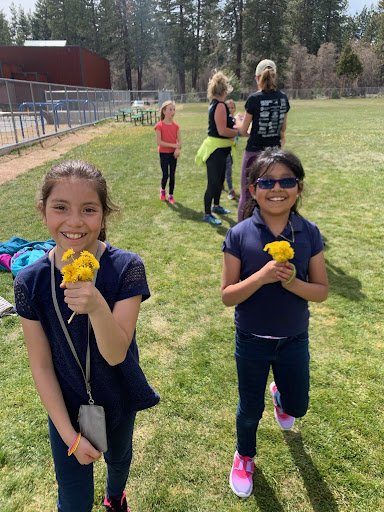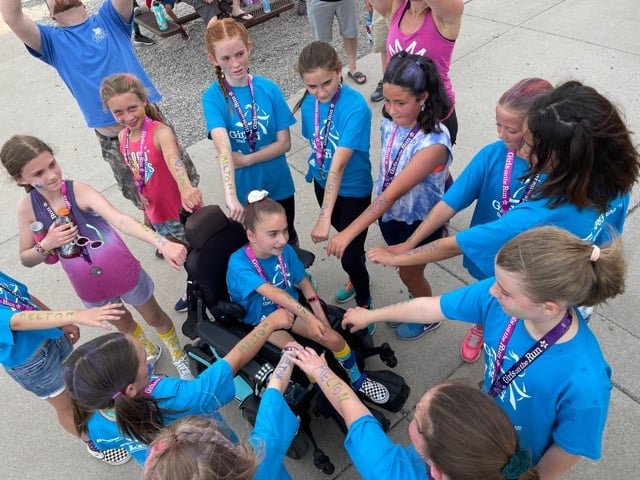“We want to make sure that girls have the confidence to ‘ignite their star power from within’ and tell themselves ‘I can do it, I’m going to try it, I’m going to do my best,’” urges Joy Heuer, Executive Director of Girls on the Run Sierras.
Girls on the Run International is a non-profit organization that was founded in 1996 in Charlotte, North Carolina, to strengthen, according to its own wording “third to eighth grade girls’ social, emotional, physical and behavioral skills to successfully navigate life experiences.”
Heuer explains how the organization first came about, with a “PE teacher named Molly who loved the physical component of running, but noticed that the girls in her classes were being overly hard on themselves and not striving to their best due to negative self-talk. Molly worked alongside schools and came up with the Girls on the Run curriculum almost 25 years ago.”
Girls on the Run now has chapters in all 50 states, and an additional chapter in Canada.
The Sierras chapter of Girls on the Run was founded in 2011, fully dedicated to making an impact on girls’ lives in the Northern Nevada and Tahoe region.
Beginning first in Truckee, GOTR Sierras has now expanded into Reno and serves the Washoe County School District as well as schools around Lake Tahoe, Truckee, and Incline. “This year has been our biggest year to date,” Joy explains. “We had over 700 girls participate over the two seasons, making up nearly 50 teams in total. We also have worked with around 200 volunteers.”
There are currently two programs available; ‘Girls on the Run’ which is offered to grades 3-5, and ‘Heart and Sole’ for girls in grades 6-8. These run for 10 weeks, with two 90-minute sessions a week.
The programs are more than just sports, however. Girls on the Run aim to make a stronger impact by teaching girls life skills such as managing emotions, resolving conflict, helping others, and making intentional decisions. “The first third of the program is all about the girl, and what makes her special and unique,” Heuer details. “The second part discusses friendships and emotions. In the last third of the program, girls form groups and begin working on a community project together. They choose a project that is important to them, whether that be writing letters to a nursing home or making fleece blankets for an animal shelter. The last step of the program is completing the 5k, and then celebrating them.”
The program curriculum is based heavily on research and is structured around understanding oneself, valuing relationships and teamwork, and recognizing how to shape the world at large. “Girls in the age group we target are like sponges,” Heuer said. “They’re constantly learning and taking in information. Age 11 is when girls typically begin criticizing themselves and their bodies and start to deal with peer pressure. We’re attempting to help them before that age so we can provide them with the tools and techniques they might need later on to help them work through confidence, body image issues, bullying; whatever they may be dealing with.”
Girls on the Run have stuck to their PE teacher roots, and work directly alongside schools in order to provide their programs.
A minimum of two GOTR volunteer coaches will hold the twice-weekly sessions at school locations, right after school. “We typically work with 3rd-5th grade teachers, PE teachers, and school counselors,” Heur explains. “They’re our biggest advocates and understand the potential of our program. School staff members have noticed themselves; Girls on the Run really does change a classroom and school. If three people in the classroom are learning compassion and how to use kind words, that will bleed into the rest of the classroom and school.”
The cost of the program is $200 per girl, however, operates on a sliding scale system, with payments of $95 or $35 available.
“We pride ourselves on never turning a girl away due to her family’s financial situation,” Heuer said. “We hold fundraisers, write grants, and work with sponsors to supplement the payments for girls who might not be able to pay the full amount. Even if they cannot pay the lowest amount, $35, we always find a way to get her into the program and her registration fees paid.”
The interest and enrollment for Girls on the Run saw a huge spike coming out of the COVID-19 pandemic. “Pre-pandemic, it was harder to convince families and schools that social and emotional learning and mental health were JUST as important as healthy eating and physical activity alone,” Heuer stressed. “Then in 2020, with the stay-at-home isolations, I think families and schools realized the importance of discussing and talking about mental health.”
Girls on the Run also sets itself apart from other sport-related program offerings because there is no try-out period. “All the girls need to do is sign up for a spot, and then you’re on the team. A lot of times, Girls on the Run is the first time a girl has ever been a part of a team before,” Heuer said. “We aim to provide girls with tools, yes, but also a sense of community. I love when we visit schools and get to see the camaraderie between the GOTR participants. Even if they’re in different grades or classrooms, when they’re together, they’re a team.”
Girls on the Run is open to all female-identifying individuals, no matter their assigned sex at birth. This past summer also saw the first rendition of “Camp GOTR”, a week-long summer camp for girls in grades 3-5. Girls on the Run partnered with FIRST NEVADA Robotics to offer coding classes to the camp participants in the afternoon. Teams worked to build a robot for their final “Mission to Mars”, after taking part in the Girls on the Run program throughout the morning session. 96 girls took part in the summer camp, filling up all the spots in two weeks. It is clear there is hot demand for this type of program, and they aim to host the summer camp every year alongside their fall and spring seasons.
As the Girls on the Run fall season approaches its end, the girls are only further gearing up for their final 5k. The race will take place on November 13th on the UNR campus, with the course beginning at William Peccole Park, snaking around campus, and then ending back at the baseball stadium.
“The physical component really is secondary in the program, so the 5k race isn’t timed. We just want the girls to put one foot in front of the other, go at their own comfortable pace, and finish. Even if they walk it, there’s absolutely no pressure,” Heuer said. Around 450 girls will be taking part in the race in November. Volunteers are needed on the 13th to help out at the race by cheering on the girls, coordinating water and snack stations, face painting, handing out finisher medals, and more. Volunteers must be 18 years old and can sign up here (applications must be in by November 8th).



